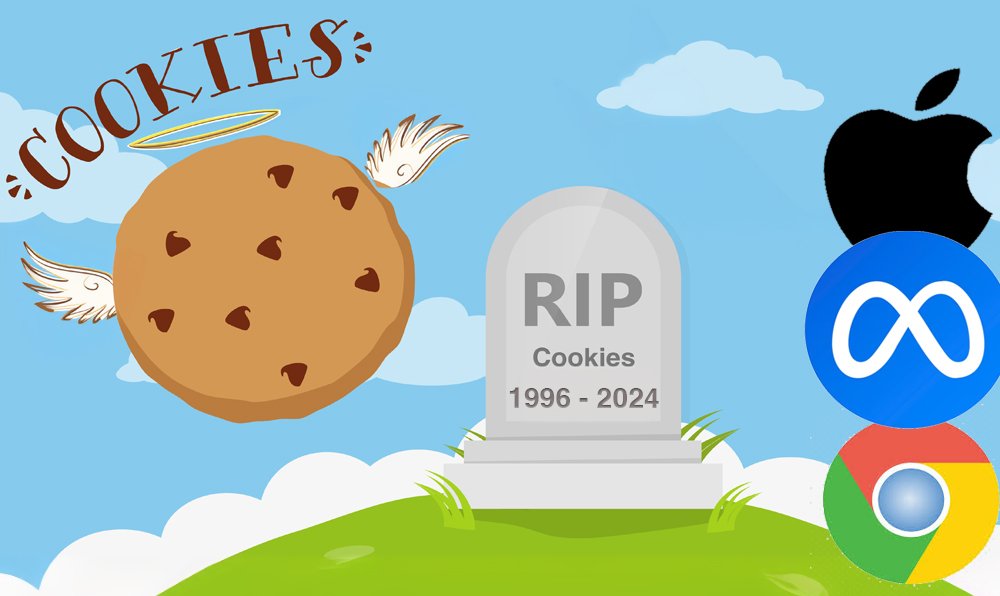By Max Milano (Tech Writer)
The word on the street is that the cookie is dead—brown bread, dead as disco, or at least the foxtrot. Digital marketing veterans are in a panic. We had it too good for too long, but now the party is over.
I blame Trump.
Hear me out. Digital marketers who have been in the trenches for a long time know this (the Trump thing). The writing has been on the wall since the iOS14 update that killed Facebook (now Meta) ads. Some may argue that Meta ads are not dead yet, but they are the ones that rely on gullible whipper snappers buying their “digital marketing mastery courses.” For the record, Meta ads are dead, or at least unconscious, and it’s all Donald Trump’s fault. You heard it here first.
But How Did Trump Kill Cookies?

Obama was the first presidential candidate to use social media excitingly to win an election. However, when Trump ran for president in 2016, his team went for the jugular and hired Cambridge Analytica. The same Cambridge Analytica that had purchased Facebook’s user data to run what some pundits have called “psychological warfare” on US voters. If by “psychological warfare,” you mean using what was then Facebook’s almost NSA level of information on its users’ behaviors, likes, and dislikes.
For us in the digital marketing world, Facebook ads at the time were a godsend (because of that same NSA level of customer data), offering low CPAs and an almost uncanny ability to dial in your target audiences’ interests. We, of course, were only selling pimple cream or run-of-the-mill SaaS products designed to help corporations run their accounting. Nothing particularly nefarious. Boring, or quaint, maybe, but if a customer wanted us to put their product in front of their ideal customer, we could dial it in very quickly with Facebook ads, thanks to the aforementioned cookies and Facebook’s treasure trove of customer data. But the party had to end someday.
We had it too good for too long. Once Trump won and Cambridge Analytica’s involvement was revealed, Facebook ad’s ability to track their customers was curtailed. Then came Apple’s near-fatal blow with their iOS14 update, eliminating third-party cookie tracking in the iOS world and thus signaling the beginning of the end for conversion tracking and any behavioral or interest-based tracking that relied on cookies.
Deprived of precious third-party data, meta ads these days are shooting blind and taking advertisers’ money for poor results. Google has followed suit by announcing the death of the cookie (it has been a slow, agonizing, but well-announced death).
What To Do Once The Cookie Is Truly Dead?

Major browsers like Google Chrome are already phasing out support for third-party cookies. This means that online businesses will struggle to gather detailed user insights, personalize content, and even retarget potential customers (i.e., Digital Marketers’ bread and butter). Is it all over, then? Maybe not.
Build a First-Party Data Strategy
The end of third-party cookies underscores the importance of first-party data – information collected directly from your audience on your website. This data is more reliable and trustworthy as it comes from users who have willingly engaged with your brand.
Here’s how to effectively collect and utilize first-party data:
Enhance Website Tracking: Implement advanced analytics tools to track user interactions on your website. Tools like Google Analytics 4 (GA4) offer enhanced tracking capabilities, allowing you to gain deeper insights into user behavior without relying on third-party cookies.
Leverage Your CRM Systems: Customer Relationship Management (CRM) systems (like HubSpot) are invaluable for storing and analyzing first-party data. Integrate your CRM with your other marketing tools to create a unified view of your customers and tailor your marketing strategies accordingly. Contact WhaleSocial to get help setting up your HubSpot CRM first-party data strategy.
Encourage Direct Engagement: Foster direct interactions with your audience through newsletters, surveys, and social media engagement. Collecting email addresses and other contact information will help you build a robust database for personalized marketing efforts. You have to go back to basics and be a real marketer.
Prioritize Your Content Marketing

Content marketing will be the most powerful tool for driving conversions in a post-cookie world.
High-quality, relevant content attracts and retains users by addressing their needs and interests.
How To Optimize Your Content Strategy:
Create Value-Driven Content: Focus on producing content that gives your audience genuine value. Whether it’s a blog post, a video, or an infographic, always ensure your content is informative, engaging, and aligns with your audience’s needs and preferences. Contact WhaleSocial to help you develop a robust content marketing strategy roadmap.
Use SEO: Optimize your content for search engines to enhance visibility and attract organic traffic. Stay on top of your keyword research, use relevant meta tags, and ensure your website’s technical SEO is up to par. Most importantly, develop an ongoing strategy for partnerships and brand collabs to keep those relevant inbound links coming.
Personalize The User Experience: Use first-party data on your website and CRM to deliver personalized content experiences. Dynamic content that adapts to user preferences can significantly improve engagement and conversion rates. HubSpot offers great personalized content options for customer journeys.
Strengthen User Relationships
Building trust with your audience is crucial in a post-cookie world. Transparency about data collection and usage can enhance user loyalty and drive conversions. Here’s how to cultivate trust:
Communicate Data Practices: Clearly explain how you collect, store, and use user data. Transparent data practices can alleviate privacy concerns and build user confidence in your brand.
Offer Value in Exchange for Data: Provide tangible benefits to users who share their data with you. This could be through exclusive content, discounts, or personalized recommendations.
Ensure Data Security: Invest in robust data security measures to protect user information. Demonstrating a commitment to data security can enhance your reputation and foster user trust.
Use Alternative Tracking Methods
Server-Side Tracking: Shift to server-side tracking to collect data directly from your server, bypassing the need for third-party cookies. This method provides more control over data collection and is less susceptible to browser restrictions.
Universal IDs: Adopt universal ID solutions that use anonymized identifiers to track users across different platforms. These solutions offer a privacy-friendly way to gather user insights while respecting user anonymity.
Consent Management Platforms: Implement consent management platforms (CMPs) to ensure compliance with data privacy regulations. CMPs help you obtain and manage user consent for data collection, fostering transparency and trust.
Focus On the User Experience (UX)
A seamless and enjoyable user experience is paramount for driving conversions. Optimize your website to ensure it meets the expectations of today’s users:
Improve Site Speed: A fast-loading website enhances user satisfaction and reduces bounce rates. Use tools like Google PageSpeed Insights to identify and rectify speed issues.
Mobile Optimization: With the increasing use of mobile devices, ensure your website is fully optimized for mobile users. A responsive design and mobile-friendly content can significantly boost conversions.
Simplify Navigation: Create a user-friendly navigation structure that makes it easy for users to find what they want. Clear calls to action (CTAs) and intuitive design can guide users toward conversion points.
Embrace Social Media Marketing

Social media platforms offer many opportunities to engage with your audience and drive conversions. Leverage these platforms to connect with users and promote your brand:
Create Engaging Content: Share content that resonates with your audience on social media. Use visuals, stories, and interactive elements to capture attention and drive engagement.
Utilize Social Commerce: Explore social commerce features like shoppable posts to streamline purchasing directly within social media platforms.
Engage With Your Audience: Foster community by actively engaging with your audience. Respond to comments, participate in conversations, and leverage user-generated content to build relationships.
A post-cookie world presents many challenges but also offers opportunities for digital marketers to engage with their audience and generate genuine brand loyalty—the time to become real marketers again versus relying on cookies and algorithms to find ideal customers. If you build it, they will come. And they will.





